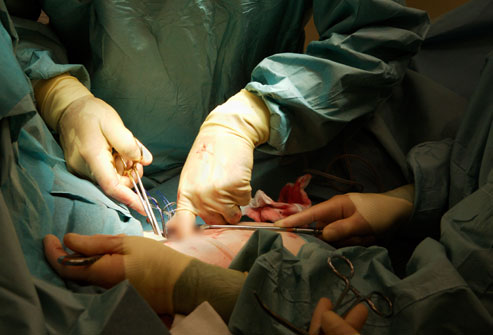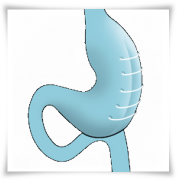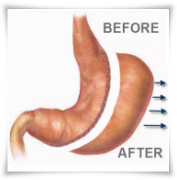Weight Loss Surgery Risks
Bariatric surgery is considered major surgery, and even those procedures that are minimally invasive, there are still weight loss surgery risks you should be aware of.
Many of the operations require general anesthesia, followed by at least 2 to 4 days of recovery in a hospital, and then many weeks to months for your body to completely recover.
General anesthesia has it’s own risks, whether it is used for weight loss surgery, or any other type of surgery. Here we will cover some of the weight loss surgery risks you should be aware of.
Click here to read more about the Gastric Sleeve.
Weight Loss Surgery Risks – In General
 There are many types of weight loss surgery, some are invasive, some are not, but the majority of the procedures will carry these weight loss surgery risks:
There are many types of weight loss surgery, some are invasive, some are not, but the majority of the procedures will carry these weight loss surgery risks:
- Sutures may be rejected
- Abdominal surgery can cause complications with your lungs and/or heart
- Bleeding
- Adhesions can result in blocked or obstructed intestines
- Hernias in the area of the operation
- General anesthesia comes with various risks (for any type of surgical procedure)
Categories of Weight Loss Surgery Risks
There are two categories of Weight Loss Surgery Risks: Early Stage and Late Stage Risks.
Early Stage Weight Loss Surgery Risks
These weight loss surgery risks can occur during the initial recovery period, within 24 to 48 hours following surgery.
Infection
After undergoing any type of surgery, there is the risk of infection and the risk is even higher in a very invasive type of procedure. An infection is one of the serious weight loss surgery risks and can lead to many other more serious complications if not treated immediately, so it is not to be taken lightly. Symptoms of an infection include:
- Malaise: You will feel tired or lacking energy, and you might sleep longer than usual. These symptoms are common following surgery but you should feel a bit better each day, instead of feeling worse.
- Fever: A fever can indicate infection, and is usually accompanied by a feeling of chilliness.
- Hot Incision: This is when the incision feels hot when you touch it.
- Redness: Redness is typical at any incision site, but it should decrease over time. If the incision is red, has red streaks leading out from the incision to your surrounding skin, it may be infected.
- Hardening and/or Swelling of the Incision: If the incision is infected it will become inflamed, which will appear as hard tissue. The incision may also start to look swollen or puffy.
- Drainage: Foul-smelling pus or fluid may appear, and it can range from white to yellow to green to red. The fluid can also appear thick, and in some rare cases, chunky. This is a definite sign of infection.
- Pain: After surgery, the pain should slowly diminish as your body heals, but if the pain at the incision site increases, you may have an infection.
Leakage
Fluid Leakage from the stomach or the intestine through the sutures or staples used can result in abdominal infection. Although it rarely happens, it is one of the more potentially serious weight loss surgery risks. A second operation will be required to drain the fluid and cure the infection.
Spleen Injury
This is one of the extremely rare weight loss surgery risks, but if it occurs it can require that the spleen be removed if the bleeding can’t be controlled.
Late Stage Weight Loss Surgery Risks
These weight loss surgery risks can occur weeks, months or even years after the surgery has been performed.
Ulcers
Ulcers can form in the small intestine or the stomach. It is not one of the typical weight loss surgery risks as it occurs in roughly 4% of all patients following a gastric bypass procedure. Ulcers are much more common in people that smoke and patients that are taking medication for arthritis.
Obstruction of the Stoma
This is another one of the rare weight loss surgery risks occurring in less than 1% of all gastric bypass patients. This happens when a piece of food that has been eaten becomes lodged or stuck in the stoma. If this happens, the food that is stuck will be removed using an endoscope (or a tube), and the food will then pass from the patient’s mouth to the stomach.
Dumping Syndrome
Patients can develop loose stool and abdominal cramps after eating certain kinds of foods. Dumping syndrome can easily be avoided if the offending foods are not eaten. Diarrhea is not one of the common weight loss surgery risks after having a restrictive procedure, and it can easily be treated with some medication. Dumping syndrome is typically associated with short periods of sweating light-headedness, and/or heart palpitations which is due to low levels of blood sugar. These types of symptoms can be reduced by simply drinking a sweetened liquid such as fruit juice. If you have undergone a malabsorptive procedure, this may be one of the more common weight loss surgery risks you will encounter.
Bariatric surgery, or any surgery for that matter, comes with risks. The type of complications that can occur will vary with the type of surgery…a gastric band has different risks than a gastric bypass, and so on. One type of surgery may carry more risks for your unique situation, so it is very important that you talk to your doctor and find out the pros and cons of each type of surgery to determine which treatment best suits you. Talk to your doctor today and learn about the all the benefits and all the weight loss surgery risks.

